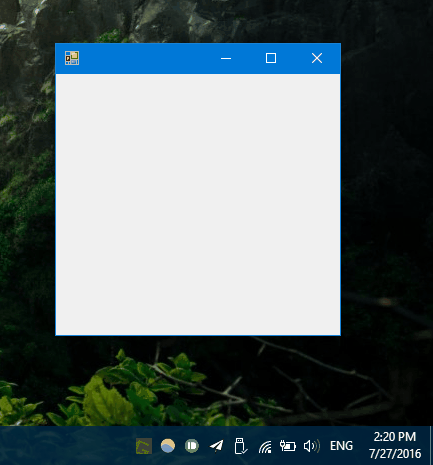Принятый ответ только привязывает окно после завершения перетаскивания, тогда как я хотел, чтобы форма непрерывно привязывалась к краям экрана при перетаскивании. Вот мое решение, свободно основанное на исходном коде Paint.NET :
using System;
using System.ComponentModel;
using System.Drawing;
using System.Runtime.InteropServices;
using System.Windows.Forms;
namespace Whatever
{
/// <summary>
/// Managed equivalent of the Win32 <code>RECT</code> structure.
/// </summary>
[StructLayout(LayoutKind.Sequential)]
public struct LtrbRectangle
{
public int Left;
public int Top;
public int Right;
public int Bottom;
public LtrbRectangle(int left, int top, int right, int bottom)
{
Left = left;
Top = top;
Right = right;
Bottom = bottom;
}
public Rectangle ToRectangle()
{
return Rectangle.FromLTRB(Left, Top, Right, Bottom);
}
public static LtrbRectangle FromRectangle(Rectangle rect)
{
return new LtrbRectangle(rect.X, rect.Y, rect.X + rect.Width, rect.Y + rect.Height);
}
public override string ToString()
{
return "{Left=" + Left + ",Top=" + Top + ",Right=" + Right + ",Bottom=" + Bottom + "}";
}
}
/// <summary>
/// A form that "snaps" to screen edges when moving.
/// </summary>
public class AnchoredForm : Form
{
private const int WmEnterSizeMove = 0x0231;
private const int WmMoving = 0x0216;
private const int WmSize = 0x0005;
private SnapLocation _snapAnchor;
private int _dragOffsetX;
private int _dragOffsetY;
/// <summary>
/// Flags specifying which edges to anchor the form at.
/// </summary>
[Flags]
public enum SnapLocation
{
None = 0,
Left = 1 << 0,
Top = 1 << 1,
Right = 1 << 2,
Bottom = 1 << 3,
All = Left | Top | Right | Bottom
}
/// <summary>
/// How far from the screen edge to anchor the form.
/// </summary>
[Browsable(true)]
[DefaultValue(10)]
[Description("The distance from the screen edge to anchor the form.")]
public virtual int AnchorDistance { get; set; } = 10;
/// <summary>
/// Gets or sets how close the form must be to the
/// anchor point to snap to it. A higher value gives
/// a more noticable "snap" effect.
/// </summary>
[Browsable(true)]
[DefaultValue(20)]
[Description("The maximum form snapping distance.")]
public virtual int SnapDistance { get; set; } = 20;
/// <summary>
/// Re-snaps the control to its current anchor points.
/// This can be useful for re-positioning the form after
/// the screen resolution changes.
/// </summary>
public void ReSnap()
{
SnapTo(_snapAnchor);
}
/// <summary>
/// Forces the control to snap to the specified edges.
/// </summary>
/// <param name="anchor">The screen edges to snap to.</param>
public void SnapTo(SnapLocation anchor)
{
Screen currentScreen = Screen.FromPoint(Location);
Rectangle workingArea = currentScreen.WorkingArea;
if ((anchor & SnapLocation.Left) != 0)
{
Left = workingArea.Left + AnchorDistance;
}
else if ((anchor & SnapLocation.Right) != 0)
{
Left = workingArea.Right - AnchorDistance - Width;
}
if ((anchor & SnapLocation.Top) != 0)
{
Top = workingArea.Top + AnchorDistance;
}
else if ((anchor & SnapLocation.Bottom) != 0)
{
Top = workingArea.Bottom - AnchorDistance - Height;
}
_snapAnchor = anchor;
}
private bool InSnapRange(int a, int b)
{
return Math.Abs(a - b) < SnapDistance;
}
private SnapLocation FindSnap(ref Rectangle effectiveBounds)
{
Screen currentScreen = Screen.FromPoint(effectiveBounds.Location);
Rectangle workingArea = currentScreen.WorkingArea;
SnapLocation anchor = SnapLocation.None;
if (InSnapRange(effectiveBounds.Left, workingArea.Left + AnchorDistance))
{
effectiveBounds.X = workingArea.Left + AnchorDistance;
anchor |= SnapLocation.Left;
}
else if (InSnapRange(effectiveBounds.Right, workingArea.Right - AnchorDistance))
{
effectiveBounds.X = workingArea.Right - AnchorDistance - effectiveBounds.Width;
anchor |= SnapLocation.Right;
}
if (InSnapRange(effectiveBounds.Top, workingArea.Top + AnchorDistance))
{
effectiveBounds.Y = workingArea.Top + AnchorDistance;
anchor |= SnapLocation.Top;
}
else if (InSnapRange(effectiveBounds.Bottom, workingArea.Bottom - AnchorDistance))
{
effectiveBounds.Y = workingArea.Bottom - AnchorDistance - effectiveBounds.Height;
anchor |= SnapLocation.Bottom;
}
return anchor;
}
protected override void WndProc(ref Message m)
{
switch (m.Msg)
{
case WmEnterSizeMove:
case WmSize:
// Need to handle window size changed as well when
// un-maximizing the form by dragging the title bar.
_dragOffsetX = Cursor.Position.X - Left;
_dragOffsetY = Cursor.Position.Y - Top;
break;
case WmMoving:
LtrbRectangle boundsLtrb = Marshal.PtrToStructure<LtrbRectangle>(m.LParam);
Rectangle bounds = boundsLtrb.ToRectangle();
// This is where the window _would_ be located if snapping
// had not occurred. This prevents the cursor from sliding
// off the title bar if the snap distance is too large.
Rectangle effectiveBounds = new Rectangle(
Cursor.Position.X - _dragOffsetX,
Cursor.Position.Y - _dragOffsetY,
bounds.Width,
bounds.Height);
_snapAnchor = FindSnap(ref effectiveBounds);
LtrbRectangle newLtrb = LtrbRectangle.FromRectangle(effectiveBounds);
Marshal.StructureToPtr(newLtrb, m.LParam, false);
m.Result = new IntPtr(1);
break;
}
base.WndProc(ref m);
}
}
}
А вот как это выглядит:
